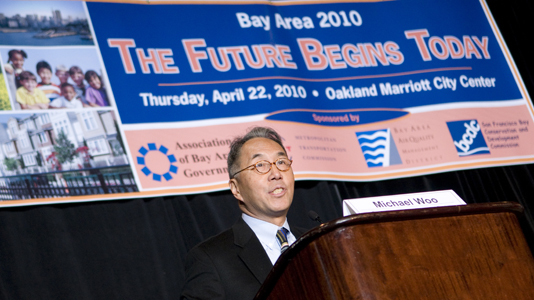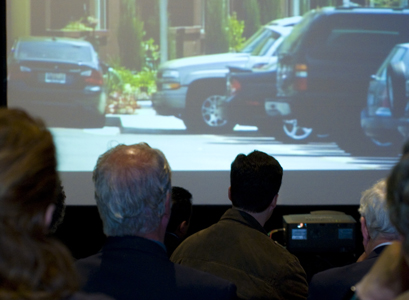For Bay Area officials grappling with how to implement stringent new state climate change legislation, the process became somewhat clearer and simpler on April 22, 2010, the 40th anniversary of Earth Day.

Keynote Speaker Michael Woo, dean of the College of Environmental Design at Cal Poly Pomona, urges the Bay Area to set the standard for sustainable planning. Photo by Karl Nielsen
By Brenda Kahn
Published: May, 2010
For Bay Area officials grappling with how to implement stringent new state climate change legislation, the process became somewhat clearer and simpler on April 22, 2010, the 40th anniversary of Earth Day. At a Summit deliberately convened on that historic day, a consortium of regional agencies unveiled a new initiative — “One Bay Area” — meant to coordinate efforts among the reigon’s nine counties and 101 cities to address this landmark legislation, Senate Bill 375.
Authored by Darrell Steinberg and passed by the California Legislature in 2008, SB 375 calls on local governments to meet tough greenhouse-gas reduction targets by retooling planning practices and zoning rules so as to minimize driving and maximize the use of alternative modes.
“SB 375 is a milestone for the state of California,” ABAG President Mark Green said in opening remarks at the Summit, held in downtown Oakland. “It is the most important legislation to come out of Sacramento in a decade.”
Spearheading “One Bay Area” are four regional agencies: the Association of Bay Area Governments (ABAG), the Metropolitan Transportation Commission (MTC), the Bay Area Air Quality Management District (BAAQMD) and the Bay Conservation and Development Commission (BCDC). These same four agencies sponsored the “One Bay Area” kick-off Summit, whose 350 or attendees included a heavy contingent of local officials — city council members, mayors and county supervisors — as well as governmental agency staff, developers and business people, community advocates and environmentalists, and the like.
SB 375 is not just a game-changer, it’s also complex — and by design will require unprecedented dialogue and cooperation among the region’s cities, counties and regional agencies, and between government types and other stakeholders.
The Summit jump-started that dialogue with a series of panels and an inspiring keynote speech by Michael Woo, a visionary who has worn several hats inside and outside of the government realm, and is currently dean of the College of Environmental Design at Cal Poly Pomona, a mayoral appointee to the Los Angeles City Planning Commission and chair of Smart Growth America, a national coalition advocating compact development.
“The Bay Area can define the edge” of innovative efforts on the part of local and regional governmental entities to address climate change, Woo said. “The work you do will set a high standard. It will demonstrate what a big region can do.”
Woo indicated that the Bay Area is at an advantage when it comes to implementing SB 375’s rigorous requirements. “There’s a sense of regional consciousness in the Bay Area that doesn’t exist in Southern California,” he pointed out. Also in the region’s favor is its trademark openness to innovation and experimentation on the part of both the private sector and government, and a strong political will to get things done.
Also giving the region a leg up, according to Woo, is the ongoing, multiagency FOCUS effort to accommodate in a sustainable manner the region’s growth from 7.1 million residents today to an expected 9 million residents by 2035 — a gain of nearly 2 million people. This FOCUS planning effort, a joint project of the four regional agencies, has already identified 120 Priority Development Areas across 60 Bay Area jurisdictions — locally identified areas near public transit that are ripe for infill development. That proximity to transit is going to be key to tackling climate change, since cars and light trucks are responsible on average for 40 percent of the greenhouse gas emissions in California — a figure that can rise as high as 60 percent in some car-centric areas of the state, according to Woo.
A highlight of the Summit was electronic voting, in which participants were asked to rank strategies for achieving public policy goals, such as shifting automobile trips to alternative modes, charging higher fees to discourage driving and boosting housing construction in climate-friendly Priority Development Areas. In an impromptu straw vote, panelist Jean Quan, vice mayor of Oakland, asked participants to indicate by raising their hands whether they support SB 375 and a sister piece of legislation, Assembly Bill 32 (which calls for a roll back across the state of greenhouse gas emissions to 1990 levels by the year 2020); the overwhelming response was to resist efforts in some quarters to repeal these ground-breaking laws, and to “stay the course” by vigorously attacking sprawl and other climate-endangering practices.
“Today is the beginning of a three-year process,” MTC Chair and Alameda County Supervisor Scott Haggerty, one of the presenters, told the audience at the Summit. That process will yield a state-mandated Sustainable Communities Strategy, an integrated transportation, land use and housing plan for the nine-county San Francisco Bay Area. This document will in turn will feed into an updated 25-year Regional Transportation Plan, which is scheduled to be adopted by MTC in 2013.
You can view a video and audio archive of the Summit and sign up for future updates on the project at www.OneBayArea.org.

Jean Quan, vice mayor of Oakland, participates in a panel on how local officials are adapting to new requirements to reduce greenhouse gas emissions through sustainable planning. Photo by Karl Nielsen

Summit videos explaining how new state greenhouse gas requirements change the planning landscape can be viewed at www.OneBayArea.org. Photo by Karl Nielsen

